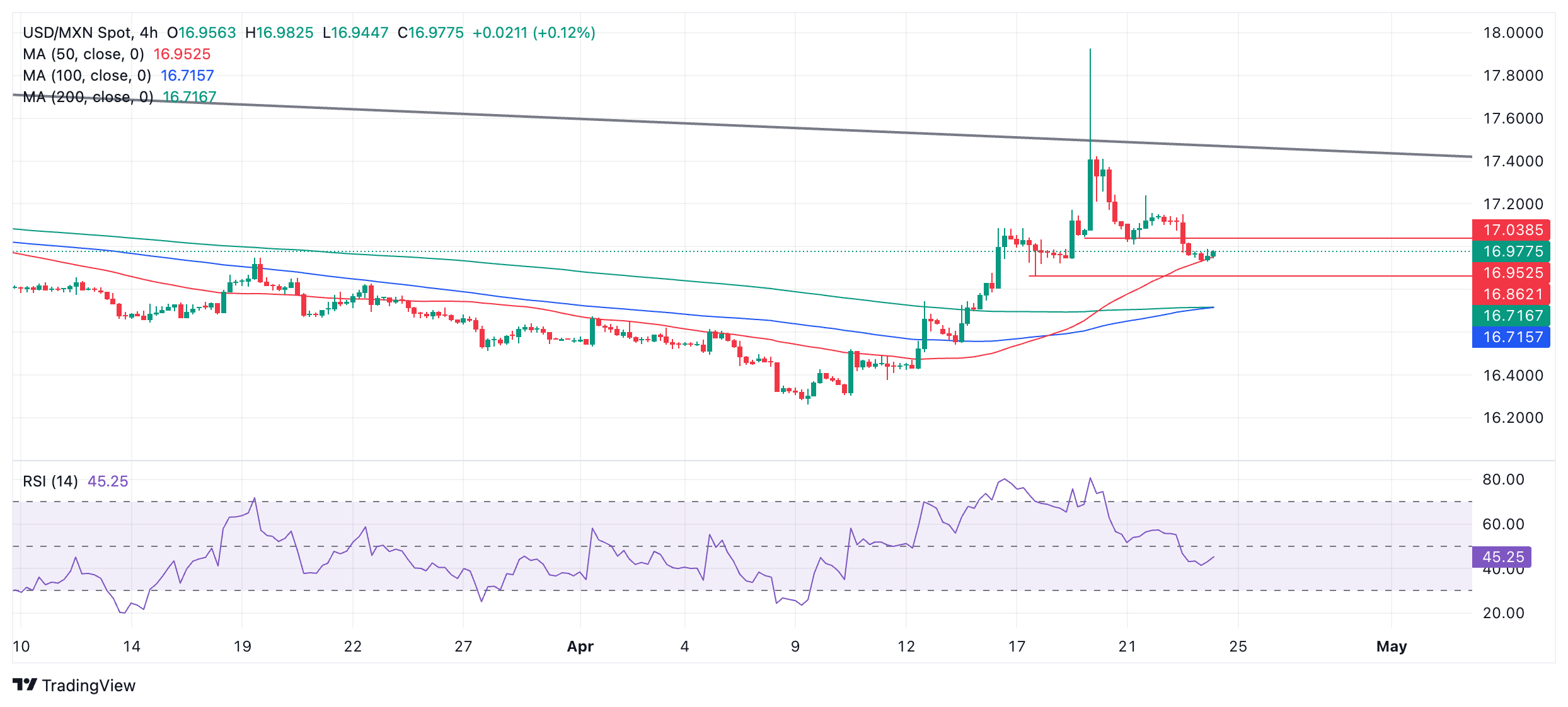- The Mexican Peso is trading higher across most major peers following the release of weak manufacturing data.
- Manufacturing PMI data released on Tuesday was lower than generally expected.
- The short-term trend of USD/MXN has likely reversed from bullish to bearish.
The Mexican Peso (MXN) is trading higher across most pairs mid-week following widespread weakness among major currencies after the release of disappointing manufacturing Purchasing Managers' Index (PMI) data weighed, especially, on the US Dollar (USD).
The Mexican peso benefits from weak manufacturing data from the US and Europe
The Mexican peso gained ground in its main pairs -USD/MXN, EUR/MXN and GBP/MXN- after the publication of PMI data that showed cracks in most developed economies. Manufacturing PMI indicators were particularly weak, and in the US unexpectedly fell into contraction territory below 50.0, standing at 49.9, well below the estimate of 52.0 and the March figure in 51.9.
In the UK, the manufacturing PMI also fell below 50, standing at 48.7, down from 50.3 previously, while in the Eurozone it fell to 45.6, missing estimates for an increase to 46.5.
In contrast, services PMIs rose by a larger margin than expected in most countries except the United States.
Despite this, markets increased their expectations of interest rate cuts by the main central banks, especially the Federal Reserve (Fed).
However, according to analysts at Rabobank, markets may be optimistic about rate cuts, citing a paragraph in PMI reports stating that factory cost pressures remain high.
“Yesterday's manufacturing PMIs screamed 'stagflation', although some heard 'rate cuts',” the Rabobank note notes.
“…but its fine print (of the PMI report) said: 'The manufacturing sector has now recorded the steepest rate of price growth in three of the past four months, with factory cost pressures intensifying in April in amid higher commodity and fuel prices, contrasting with price pressures driven by wage-related services seen throughout much of 2023,'” the Rabobank note continues, suggesting that the impact on currencies could be short-lived.
Inflation in Mexico, in focus
Mexico's mid-April inflation data, released Wednesday at 12:00 GMT, could adjust expectations about Banxico's policy approach going forward, given its insistence on reliance on data, as revealed in the minutes of the last meeting.
Mexican inflation in the first half of March is expected to remain at 4.48% year-on-year. On a month-on-month basis, prices are expected to decline 0.03% after rising 0.27% in the previous reading.
Semi-annual core inflation is expected to decline to 4.39% annually in March, down from 4.69% previously. In monthly terms, inflation would drop to 0.16% from 0.33% previously.
A higher result than the previous one is likely to further reduce the likelihood of the central bank making another short-term cut following the March rate cut, and vice versa for a lower result than the previous one.
Higher interest rates tend to appreciate a currency by attracting more foreign capital inflows, and the opposite is true for lower interest rates.
Technical Analysis: USD/MXN Short-Term Trend Likely Bearish
USD/MXN has likely reversed its near-term uptrend after breaking below the key hurdle of 17.00, the previous highest low, and more weakness is now expected as the bears take control.
USD/MXN 4-hour chart

The next key support level is at 16.86, where a major moving average is also located, providing dynamic support on a longer time frame chart. A decisive break below could lead to further weakness to 16.50 and then to the April 9 lows of 16.26.
A decisive break above the main trend line for the long-term downtrend at around 17.45 will now be necessary to give bulls renewed confidence, and activate an upside target at around 18.15.
A decisive breakout would be characterized by a longer than average daily candlestick piercing above the trend line and closing near its high, or by three consecutive green candlesticks piercing above the level.
economic indicator
first semester inflation
The underlying inflation index for the first semester published by the Bank of Mexico is a measure of the evolution of prices by comparing the retail prices of a representative shopping basket of goods and services. The purchasing power of the Mexican peso is dragged down by inflation. The inflation rate is a key indicator as it is used by the central bank to set interest rates. Generally speaking, a high reading is considered positive (or bullish) for the Mexican peso, while a low reading is considered negative (or bearish).
Read more.
Next post: Wed Apr 24, 2024 12:00
Periodicity: Monthly
Consensus: -0,03
Former: 0 ,27
Fountain: National Institute of Statistics and Geography of Mexico
Source: Fx Street
I am Joshua Winder, a senior-level journalist and editor at World Stock Market. I specialize in covering news related to the stock market and economic trends. With more than 8 years of experience in this field, I have become an expert in financial reporting.







